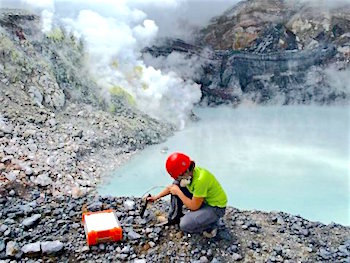 Researchers at CU Boulder have discovered microbes living in a toxic volcanic lake that may rank as one of the harshest environments on Earth. Their findings, published recently online [in Astrobiology], could guide scientists looking for signs of ancient life on Mars.
Researchers at CU Boulder have discovered microbes living in a toxic volcanic lake that may rank as one of the harshest environments on Earth. Their findings, published recently online [in Astrobiology], could guide scientists looking for signs of ancient life on Mars.
The team, led by CU Boulder Associate Professor Brian Hynek, braved second-degree burns, sulfuric acid fumes and the threat of eruptions to collect samples of water from the aptly-named Laguna Caliente. Nestled in Costa Rica’s Poás Volcano, this body of water is 10 million times more acidic than tap water and can reach near boiling temperatures. It also resembles the ancient hot springs that dotted the surface of early Mars, Hynek said.
The Costa Rican lake supports living organisms—but only one. Hynek and his colleagues found microbes belonging to just a single species of bacteria in the lake water, a rock-bottom level of diversity.
“Even in an extremely harsh environment, there can still be life,” said Hynek of the Laboratory for Atmospheric and Space Physics and Department of Geological Sciences. “But then there’s very little life. Mars was just as extreme in its early history, so we should probably not expect to find evidence of large-scale biodiversity there.”
Hynek, who is also the director of CU Boulder’s Center for Astrobiology, has spent much of his career searching for places on Earth today that look like Mars did nearly four billion years ago. At that time, liquid water was plentiful on the surface. His goal is to better understand the environments where life may have evolved on the Red Planet.
It’s a hard task: Rampant volcanism during that period created volatile and mineral-rich pools of water, giving rise to “Yellowstones all over Mars,” Hynek said. [More at links]








